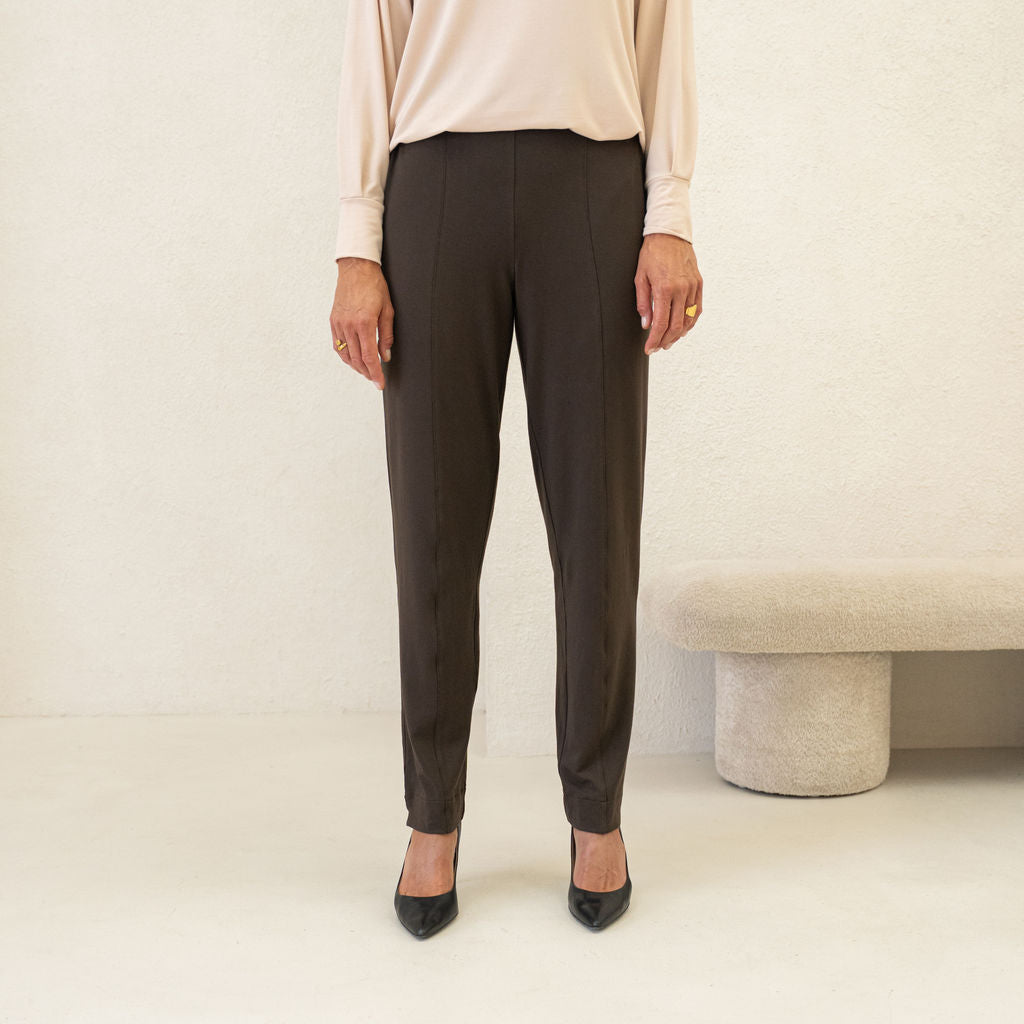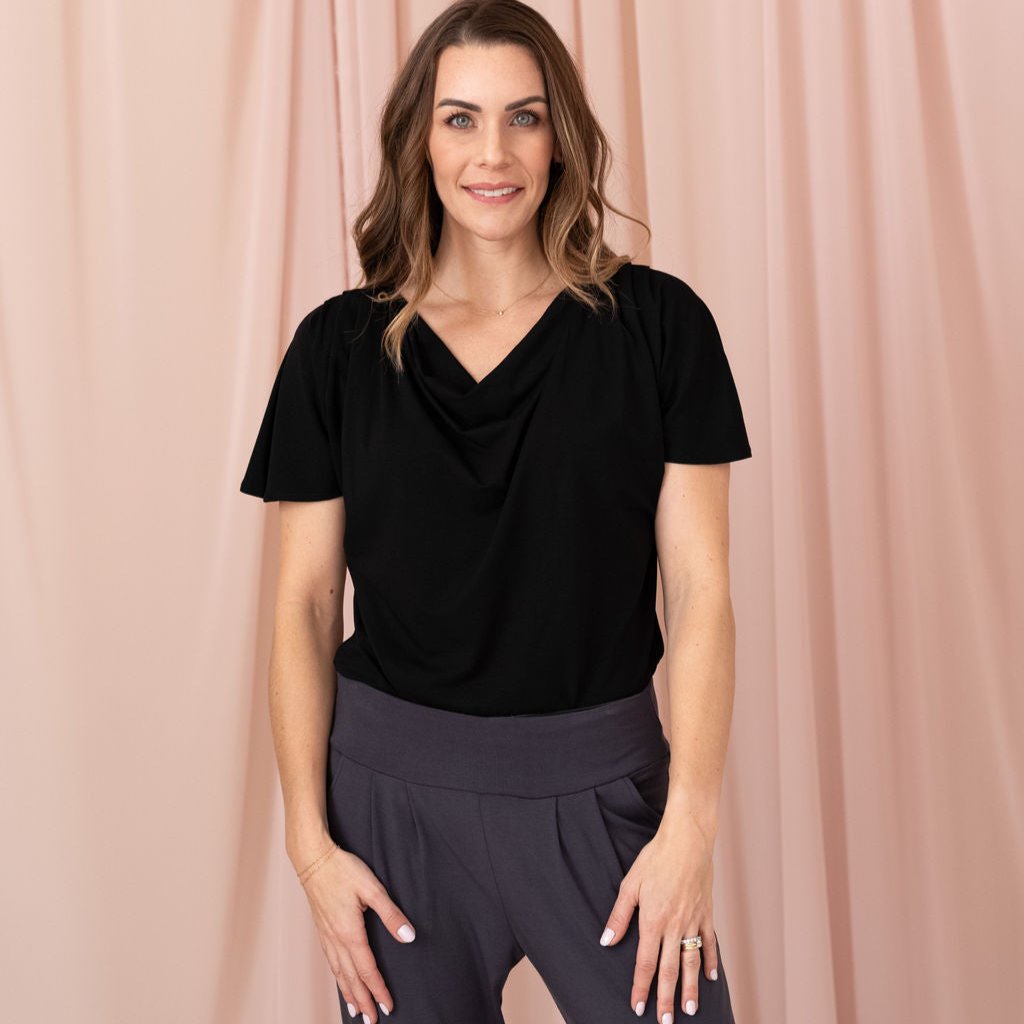
When it comes to clothing, the most sustainable thing you can do is wear what’s already in your closet. But what if your favourite shirt is missing a button or has a hole? Instead of shopping for a replacement, we want to help learn some basic sewing repairs, so you can repair that shirt and get it back into the rotation. Repairing clothes is a great skill to have and there's no time like the present to get started on learning the sewing basics!
Our amazing production team at Encircled put together some easy to follow sewing alteration tutorials for how to fix a few of the most common clothing flaws. Below, you'll find tutorials for how to sew a hole, sewing on a snap, sewing a button back on, and spot cleaning.
No sewing machine? No problem. We wanted to make sure anyone would be able to do these repairs, so none of these tutorials require a machine. We’ll also be starting off with a lesson on basic sewing for anyone new to sewing, or just looking for a refresher!
Sewing 101 - Hand Sewing
Hand sewing is an essential skill for anyone to have. Having the right tools and tips for hand sewing will allow you to make little sewing repairs at home quickly and easily, instead of taking a garment to the tailor (saving you time and money, win!) or just leaving the damaged garment in the back of your closet never to be worn again. Most importantly, you will be able to easily extend the life of your clothing - check out our page on circular fashion for tips on parting with clothes in an eco-friendly way when they are at the end of their lifecycle.
Tools you will need:
Must Haves- Sharps (aka: Hand sewing Needles)
- Thread Spool: Cotton, Polyester, or a blend is fine
- Scissors: Small embroidery scissors or sewing snips will help you trim away little threads the best, but kitchen/craft scissors work fine in a pinch
- Straight pins: To keep fabric in place when sewing, or to mark a spot. The kind with ball heads are nice so you don’t get poked!
- A seam ripper: To take out stitches that didn’t work out
- A ruler: For making sure you know exactly where to sew before you start sewing
Nice to Haves
- Tailors Chalk or Tailors Marker: For marking spots in the fabric. These markers are designed to wash out of fabric
- Iron, Ironing board and Press cloth: An old t-shirt or pillow case works great as a press cloth
- Wire Needle Threader: If you have a tough time threading needles
Whatever project you are about to embark on, there are some key first steps:
Picking your sewing needle
Take one of your sewing needles “aka sharps” out of the pack. The most common packs have a variety of sizes in them. The size you pick will be determined by the type of project you are working on.
For example, if you are sewing on a button, you will want to look at the holes in the button and make sure the sewing needle you choose will fit through the button holes. If you are going to be sewing through thick or multiple layers of fabric, a larger needle is better as it will push through the layers of fabric more easily than a small needle.
Threading your sewing needle
Once you have chosen your sewing needle, it’s time to thread it. Grab your thread spool and unwind a length of it. The longer your thread is the more difficult it is to control your stitches. So, start small. A nice starting point is to wind out a length of thread the length of your arm. When you are more comfortable with hand sewing you may choose to unwind a longer amount of thread so you don’t have to stop and rethread your needle as often.
Snip your thread off the spool with your scissors. Now take one end of the thread, and “thread” it through the small hole in the top of the sewing needle. This may take a few tries! Licking the end sometimes helps to keep the fibres together (only do this for your personal repairs for hygienic reasons), or you can recut the end with your scissors until you get a clean end.
If you have a wire needle threader, this is your time to use it. You simply pull your thread through the wire and fold it back over itself so you are holding both loose ends of the thread, and the thread is looped into the wire. Now push the entire wire through the hole in the needle. Once it is through, drop one loose thread end and pull it fully through on the other side of the needle hole, and remove it from around the wire. Grab both loose ends, now on either side of the needle, and hold tight while you remove the wire needle threader.
Once you have your thread end through the needle hole, bring your two loose thread ends together on either side of the needle and straighten them out so the needle meets cleanly in the middle of the thread. Knot the two loose thread ends together, leaving a “tail” of about 1 inch. Pull them tight so they don’t come loose during sewing!
Marking your spot
Whatever project or clothing repair you are working on, you will need to mark the spot that you will be sewing in. Doing this ahead of time will save you a lot of frustration in the future if your button doesn’t line up with your button hole, or if your seam isn’t quite straight.
You can use a straight pin with a ball head to mark your spot if you don’t have tailors chalk or a tailors marker. Most sewing kits have pins, so this is a readily available option.
You can mark your spot with tailors chalk or a tailors marker, but remember you will need to wash the garment after the repair to get these out. They are nice options because they stand out and give you flexibility to move the fabric around without poking yourself!
Use your ruler to measure precisely where your sewing repair will be done. For example, with a button, you will measure the distance between buttons, and the distance from the neckline of the shirt to where your button hole is, to determine where you need to resew your button. Once you have determined where your clothing repair will be done, you can either stick a pin in vertically in the place you need to mark or you can draw a small mark (a dot, cross or an x is fine, whatever you can see best) with your tailors chalk or marker.
If you use the pin option, stick the pin into the fabric straight down so the ball head is right on the spot you are marking, then bring the end of the pin back up through the underside of the fabric so it pokes out the top of the fabric again. The pin will be secure in this position, and you can get to repairing clothes!
Removing Stitches
If you made a stitch you don’t like, want to redo the repair for a cleaner finish, or need to remove any stray threads from the area you are about to repair, this is when the stitch ripper comes in handy.
Using the little sharp tip at the end, slide the tip under the thread of the stitch you wish to remove. The inside of the stitch ripper is sharp, so when you press against the thread and then pull upward, it will cut the thread. Sometimes you only need to stitch rip one thread and the entire row of stitch you made will come undone, other times you need to stitch rip a few to get all the thread out.
No matter what though, if you stitch rip you will need to start your repair over. Once one thread is loose, they will all eventually come loose, even if it doesn’t feel like it right then and there. So make sure you remove everything, and you can start fresh!
Now that we've got the basics down, it's time to get sewing!
How to Sew a Hole
- When sewing a hole, you want to make sure the garment is inside out. This will ensure most of the stitches are hidden on the inside of the garment.
- The goal is to connect both sides of the hole to close it. Start at one end of the hole, and work your way across it catching fabric from one side to the other.
- Make sure you are not catching too much fabric as it will be more noticeable when finished, however too little fabric will only cause the hole to appear again.
- When the hole is closed, sew a few stitches to finish it off. We suggest knotting the last one to make sure my sewing doesn’t unravel.
- Turn your garment right side out, and give it a quick press with a pressing cloth, or steam. This will flatten the surface so the stitches are less noticeable. You now know how to sew a hole!
How to Sew a Snap
- Begin by securing your knotted thread with a few stitches where your snap will go.
- Bring your needle through the first hole of the snap. Sew a few stitches here, making sure you are catching the fabric underneath.
- In this case, we want the snap to be sewn on the inside of the hem. Make sure you are going through only one layer of fabric on the hem, otherwise your stitches will be visible from the right side of the garment.
- After the first hole has been sewn, catch the fabric but this time move your needle to the placement of the second hole. Come up through the second hole and repeat the same steps.
- Continue these steps until all 4 holes are securely sewn.
- When finished, sew a few stitches underneath the snap. This will secure your sewing and also hide the stitches.
How to Sew a Button
- First, secure your knotted thread with a few stitches where your button will be.
- Place your button where you want to sew it on, and bring your needle up through the first hole from the back of the button.
- Now going across the top of the button, put your needle down through the hole next to it. Catch some fabric before bringing your needle back up through the first hole again. Repeat this a few times.
- Make sure your button is slightly tilted when sewing to make sure it is not sewn on too tight. Sewing it on too tight will result in a button that does not go through the button hole easily.
- For a four hole button, you will continue these steps with the remaining two holes.
- After sewing on the button, wrap the thread around the button 3 or 4 times. This is another way to ensure the button is not sewn on too tight.
- Sew a few stitches underneath the button to secure it down before cutting your thread.
Removing a Stain
- To make your stain removing solution, you're going to mix equal parts laundry detergent and water, then add baking soda until it becomes a paste.
- Apply it to the stain and let it set for up to an hour. It is best to let it sit in a warm environment, like the bathroom, so the solution doesn’t dry on the garment.
- Rinse the spot out with water, and the stain should be gone! Ps. keep this one in mind when you're shopping our sample sale. We suspect it'll come in handy!
We hope you gained some new skills from our sewing repair tutorials! Not only can you now repair your own clothes to get more wear out of them, but the next time a friend asks how to sew a hole or how to sew a button, you’ll be able to impress them with your new skills!
Let us know in the comments what sewing repairs you would like a tutorial for next!
All photos are copyright Encircled. Contact us for permissions/rights to re-use or repost images.






2 comments
Great tips! I would also love to see some guidance on the best way to fix pulls in fabric (there’s a pull in my chrysalis cardi waiting for some TLC).
Very helpful and user friendly!
Leave a comment